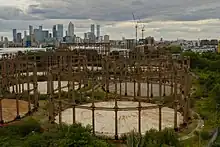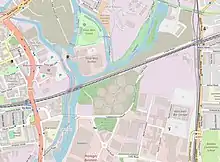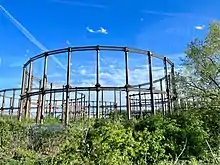
The Bromley-by-Bow gasholders are a group of seven cast iron Victorian gasholders in Twelvetrees Crescent, West Ham and named after nearby Bromley (now Bromley-by-Bow) in the London Borough of Tower Hamlets.
Built between 1872 and 1878 to store gas from the nearby Bromley gasworks, the site stopped storing gas in 2010, and is currently a brownfield site. They are thought to be the largest group of Victorian gasholders in Britain, with the Victorian Society calling them "a true symbol of the Industrial Revolution".[1]
History
Historically, the site was marshland on the River Lea. In the early 1800s, William Congreve built a factory for his Congreve rockets on a 14 acre site.[2][3]

In 1870, the Imperial Gas Light and Coke Company began work to build their largest gasworks at Bow Creek near Bromley, to compete with the Beckton Gas Works of their major competitor, the Gas Light and Coke Company. The works would be around 170 acres in size, replacing the rocket factory.[2] Prior to completion of the Bromley gasworks, the Imperial was absorbed by the Gas Light and Coke Company (GLCC).[4]
To store the gas produced at the gasworks, nine gasholders were built north of the gasworks between 1872 and 1878, designed by engineers Joseph Kirkham, Thomas Clark and Vitruvius Wyatt.[5] Gas was delivered to nearby factories, homes and businesses from 1873, and was originally used for gas lighting. Over time, gas was also used for heating and cooking.[4][6]
During World War II, the site was bombed in 1940, damaging several of the gasholders. Gasholder number 5 was subsequently removed, and the frame of gasholder number 3 was removed, leaving a circular lake.[5] In 1949, the GLCC was nationalised, with the site falling under the ownership of the North Thames Gas Board.[6][7]
After the discovery of North Sea natural gas in 1965, gasworks were subsequently closed across the UK - with the Bromley gasworks closing in 1976.[5][7] The gasholders remained, used to store gas under compression prior to use. The Bromley gasworks located to the south of the gasholders were subsequently redeveloped into an industrial park in the later half of the 20th century.[5]
Heritage protection

In 1984, the gasholders were collectively Grade II listed. This heritage protection was upgraded in 2021, with each gasholder individually listed, as well as the entire group.[5]
Historic England notes that they are "among the most aesthetically distinguished and finely detailed gasholders ever built", with Doric and Corinthian columns, decorative ironwork, and they follow classical architectural rules. They also note that the gasholders are a "unique architectural grouping", as the largest group of Victorian gasholders in the UK.[5]
Nearby to the gasholders, the Twelvetrees Crescent Bridge, the statue of Sir Corbett Woodall (former governor of the GLCC) and the Gas Light and Coke Company war memorials are also listed.[8][9]
Future
In 2010, use of the site to store gas ended. The site is now owned by Cadent Gas, who oversee the national gas distribution network in the UK.[5] Various proposals to reuse the site have been suggested, including converting them to an urban park for industrial tourism,[10][11] or a zoo using the gasholder structures.[12][13] There is no public access to the site, however the gasholders are visible from nearby Twelvetrees Crescent, Three Mills and from the London, Tilbury and Southend railway line.
In 2018, they were named among the top ten endangered buildings of the Victorian and Edwardian eras in a survey released by the Victorian Society.[1][14] The Victorian Society has pushed for greater preservation of gasholders, noting that "by their very size and structure, cannot help but become landmarks. [They] are singularly dramatic structures for all their emptiness."[15]
As of 2022, Berkeley Homes (under their St William brand, which specialises in regeneration of brownfield sites) proposes the redevelopment the site for housing, while refurbishing and keeping all seven remaining gasholders.[16][17] This has already occurred at other developments in London, such as the Oval Gasholders.[17]
References
- 1 2 "Victorian Society reveals top 10 buildings 'crying out' to be saved". BBC News. 12 September 2018. Retrieved 22 October 2022.
These seven gasholders - an eighth was destroyed by a bomb in World War Two - in east London are surrounded by industrial development. The society said the value of so many Victorian gasholders packed together was "unmatched anywhere else in the world". It said this made the collection a "true symbol for the Industrial Revolution and historically of high significance".
- 1 2 "Site History". Bromley-by-Bow Gasworks. Retrieved 23 October 2022.
- ↑ "The legacy of the River Lea | Canal & River Trust". canalrivertrust.org.uk. Retrieved 23 October 2022.
- 1 2 Everard, Stirling (1992). The history of the Gas Light & Coke Company, 1812-1949. London: A & C Black. ISBN 0-7136-3664-5. OCLC 224220550.
- 1 2 3 4 5 6 7 "Gasholder No 4, former Bromley-by-Bow gasworks, Non Civil Parish - 1190911 | Historic England". historicengland.org.uk. Retrieved 22 October 2022.
- 1 2 Williams, Trevor I (1981). A History of the British Gas Industry. Oxford: Oxford University Press. ISBN 0-19-858157-2.
- 1 2 Thomas, Prof. Russell (2020). "The Manufactured Gas Industry: Volume 3 Gazetteer". Historic England. pp. 208–209.
- ↑ Wignall, Katie (12 May 2020). "A Secret Garden in the Former Bromley-by-Bow Gas Works". Look Up London Tours. Retrieved 22 October 2022.
- ↑ "Gas Light and Coke Company War Memorial Plaque, Non Civil Parish - 1477363 | Historic England". historicengland.org.uk. Retrieved 22 October 2022.
- ↑ Kleebauer, Alistair (16 April 2008). "Talk of closing gasworks is not just hot air". East London Advertiser. Retrieved 22 October 2022.
- ↑ "Background information about the Lea River Park project". Lea River Park. 8 April 2012. Archived from the original on 8 April 2012. Retrieved 22 October 2022.
This huge site is currently used by National Grid for gas storage. It will become a major new visitor destination for London incorporating activities and facilities within the frames of the listed gasholders. The new parkland at Twelve Trees will provide a link to connect Bromley-by-Bow with West Ham.
- ↑ Staff Reporter (26 June 2013). "Fancy a swim in a Tube tunnel? Inspiring ideas for regenerating". Evening Standard. Retrieved 22 October 2022.
- ↑ "A Lost World - Forgotten Spaces 2013". RIBA. 2 July 2013. Archived from the original on 2 July 2013. Retrieved 22 October 2022.
A zoo complex in a decommissioned gas holder whose by-products, through anaerobic digestion, cyclically support the site and surroundings.
- ↑ "Great Yarmouth Winter Gardens among UK's most at-risk buildings". The Guardian. 11 September 2018. Retrieved 22 October 2022.
- ↑ O'Hagan, Sean (14 June 2015). "Gasworks wonders…". The Guardian. Retrieved 22 October 2022.
- ↑ "Victorian gas holders to become homes under National Grid plan". The Guardian. 7 November 2014. Retrieved 22 October 2022.
- 1 2 "Bromley by Bow gasworks". Bromley-by-Bow. 2022. Retrieved 22 October 2022.